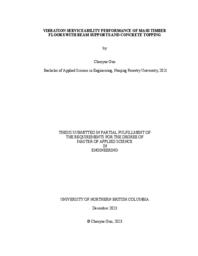Guo, Chenyue
Person Preferred Name
Chenyue Guo
Related Works
Content type
Digital Document
Description / Synopsis
Mass timber panels are frequently utilized as load-bearing components in the construction of floors, walls, and roofs within mid-rise or high-rise wooden buildings. In comparison to other building materials like concrete and steel, floors constructed using mass timber panels have relatively lighter weight and lower bending stiffness, which makes them more susceptible to vibrations resulting from human activity. The floor vibration can significantly affect the comfort of its occupants, and the vibration serviceability limit design often governs the maximum allowable span of mass timber floors. The limited quantity and complexity of research on the vibration performance of mass timber floors underscore the urgent need for further investigation. This research focused on assessing the vibration performance of mass timber slab floors with beam supports and concrete toppings. The two investigations included experimental tests to determine the dynamic properties of these floors and gathered subjective ratings from occupants to evaluate the floor's vibration performance. Additionally, numerical modeling approaches were suggested in each study and verified by using test results. The applicability of three contemporary design methods for timber floor vibration was assessed by comparing the experimental results with the predictions generated by each method. The results of this research have highlighted the significant influence of support stiffness on the vibration performance and dynamic properties of mass timber slab floors. Transitioning from rigid wall supports to realistic beam supports can cause a notable shift in the floor's vibration performance, potentially moving it from acceptable to unacceptable. In such cases, the fundamental natural frequency can decrease by more than 40%, but the deflection under point load remained consistent. The method proposed by Kollar demonstrated a remarkable level of accuracy in predicting the fundamental natural frequency of beam-supported floors. The impact of adding a floating concrete topping to the floor's dynamic properties depends on specific construction details like support conditions and floor-to-concrete thickness ratio. Within this research, introducing a floating concrete topping to mass timber floors significantly improved their vibration performance. This improvement had the potential to change the initial subjective rating of the floor from unacceptable to acceptable. Various degrees of partial composite action were observed between the concrete and timber layers depending on different floor assemblies. The commonly used floor vibration design methods exhibited limitations when employed in the design of mass timber floors with varying construction details. To achieve more accurate predictions of their vibration performance, future study is recommended.
Origin Information

